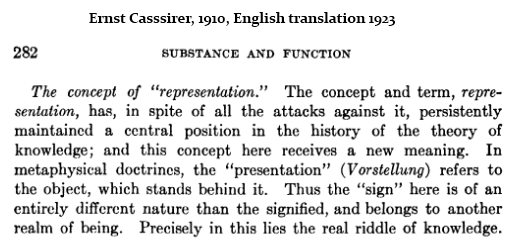But with good Will
To show our simple skill…
( Continued from Midsummer Eve, 1993 )
The "Black Diamond" search from Holy Cross Day
leads to Talk Amongst Yourselves, which in turn
leads to PyrE in the Book, with Alfred Bester's
version of "Will and Idea."
This phrase may be regarded as a version of
Schopenhauer's "Will and Representation."
Related material—
"Schopenhauer's notion of the will comes from the Kantian thing-in-itself, which Kant believed to be the fundamental reality behind the representation that provided the matter of perception, but lacked form. Kant believed that space, time, causation, and many other similar phenomena belonged properly to the form imposed on the world by the human mind in order to create the representation, and these factors were absent from the thing-in-itself. Schopenhauer pointed out that anything outside of time and space could not be differentiated, so the thing-in-itself must be one and all things that exist, including human beings, must be part of this fundamental unity. Our inner-experience must be a manifestation of the noumenal realm and the will is the inner kernel* of every being. All knowledge gained of objects is seen as self-referential, as we recognize the same will in other things as is inside us." —Wikipedia
* "Die Schrecken des Todes beruhen großentheils auf dem falschen Schein, daß jetzt das Ich verschwinde, und die Welt bleibe, Vielmehr aber ist das Gegentheil wahr: die Welt verschwindet; hingegen der innerste Kern des Ich, der Träger und Hervorbringer jenes Subjekts, in dessen Vorstellung allein die Welt ihr Daseyn hatte, beharrt."
— Schopenhauer, Die Welt als Wille und Vorstellung , Kapitel 41
Added Nov. 16, 2012, a translation by E. F. J. Payne—
"The terrors of death rest for the most part on the false illusion that then the I or ego vanishes, and the world remains. But rather is the opposite true, namely that the world vanishes; on the other hand, the innermost kernel of the ego endures, the bearer and producer of that subject in whose representation alone the world had its existence."
— THE WORLD AS WILL AND REPRESENTATION
by Arthur Schopenhauer
Translated from the German by E. F. J. Payne
In two volumes
© 1969 Dover Publications, Inc.
© 1958 by The Falcon's Wing Press
Volume Two: Supplements to the Fourth Book,
XLI. On Death and Its Relation to the Indestructibility of Our Inner Nature





